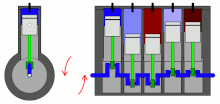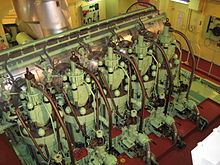Straight-five engine
The straight-five engine (also referred to as an inline-five engine; abbreviated I5 or L5) is a piston engine with five cylinders mounted in a straight line along the crankshaft.
Although less common than straight-four engines and straight-six engines, straight-five engines have occasionally been used by automobile manufacturers since the late 1930s, particularly the Mercedes Benz's diesel engines from 1974 to 2006 and Audi's petrol engines from 1979 to the present. Straight-five engines are smoother running than straight-four engines and shorter than straight-six engines. However, achieving consistent fuelling across all cylinders was problematic prior to the adoption of fuel injection.
Characteristics[edit]


Straight-five engines are typically shorter than straight-six engines, making them easier to fit transversely in an engine bay.[1] They are also smoother than straight-four engines,[1] and are narrower than V engines[2] and flat engines.
Engine balance and vibration[edit]
Five-cylinder engines have a crankshaft with 72 degree angles.[3] Amongst four-stroke engines, an advantage of engines with five or more cylinders is that the power strokes are overlapping (if the engine has an even firing order).[1]
On the other hand, the odd number of cylinders in a straight-five engine results in imperfect primary and secondary engine balance (unlike a straight-six engine). Counterweights on the crankshaft (also used in straight-four engines) can be used to reduce the vibrations from these imbalances.[4][5]
Firing order[edit]
Most four-stroke straight-five engines use a firing order of 1-2-4-5-3.[citation needed] This firing order results in the minimal primary (crank speed) rocking couple, and is used by the Volvo Modular engine, VW/Audi straight-five engine, General Motors Atlas engine and Honda G engine. Straight-five engines typically have a 72 degree crankshaft design.[6]
All two stroke straight-five engines are limited in having a single firing order for a given crank configuration; because a complete cycle occurs every 360 degrees, there is no chance to share piston phases without having simultaneous ignitions, so the straight-five is at no disadvantage in this case. Some two-stroke outboard engines, e.g. the Mercury Marine Force 150 engine use a firing order of 1-5-2-3-4.[7]
Carburettors and fuel injection[edit]
The use of straight-five petrol engines in mass production cars only became truly viable with the advent of reliable fuel injection. This is because of the unavoidable problems of a carburettor supplying an odd number of cylinders and the length of the inlet manifold between the carburetor varying greatly between cylinders at the ends of the engine and those nearer the carburetor. Unlike other engine layouts, these problems are not easily solved by using multiple carburettors.
Diesel engines have always used fuel injection, therefore large displacement straight-five diesel engines were commonly seen decades before straight-five petrol engines.
Usage in automobiles[edit]
Diesel engines[edit]
The 1938 Lancia 3Ro trucks introduced a straight-five diesel engine to replace the previous straight-three engine. Built for the Italian and German armed forces during World War II and later for civilian usage, the truck remained in production until 1950.[8]
The first mass-production straight-five passenger car engine was the 1974 Mercedes-Benz OM617, a naturally-aspirated 3.0 L (183 cu in) engine introduced in the Mercedes-Benz 300D (W114/W115) models. In 1978, a turbocharged version was introduced in the Mercedes-Benz 300SD Turbo models. Mercedes-Benz continued to produce straight-five engines for the next 28 years, until the Mercedes-Benz OM647 engine ended production in 2006.
In 1978, the Audi 2.0 R5 D engine was introduced in the Audi 100 sedan. In 1983, a turbocharged version was introduced, initially for the U.S. market Audi 100. Several Volvo cars were produced with Audi straight-five diesel engines, prior to the introduction of the Volvo D5 turbo-diesel engine; this engine was produced from 2001 to 2017 and was used in several diesel hybrid applications (marketed as "twin engine" models).[9][10]
Other mass-production straight-five diesel engines include the 1999–2001 VM Motori 531 turbo-diesel engine,[11] the 1998–2007 Land Rover Td5 turbo-diesel engine, the 2006–2019 Ford Duratorq 3.2 turbo-diesel engine and the 1998–2009 Fiat JTD 2.4 turbo-diesel engine.
Petrol engines[edit]
Henry Ford had an inline-five engine developed in the late 1930s to early 1940s for a compact economy car design, which never saw production due to lack of demand for small cars in the United States.[12]
The first production straight-five petrol engine was the Audi 2.1 R5 introduced in the Audi 100 in 1979. Audi has continued use of straight-five petrol engines (in both naturally aspirated and turbocharged versions) to the present day. The Audi TT RS and Audi RS3 currently use straight-five engines.[13] In motorsport, the first car to use a straight-five engine was the Audi Quattro rally car;[14] other racing cars which used straight-five engines include the 1985-1986 Audi Sport Quattro E2 and the 1989 Audi 90 Quattro IMSA GTO.[15][16][17][18] For the year 1987 factory team tested a 1000 hp version of the inline-5 powered Audi S1 Sport Quattro.[19]
Several Volkswagen-branded straight-five engines have been produced, beginning with the Volkswagen WH/WN 1.9 litre 10v engine used in the 1981 Volkswagen Passat. The final Volkswagen straight-five petrol engine was the Volkswagen EA855 2.5 litre 20v engine used in the North American Passat models until 2014.[20]
The Volvo Modular engine was introduced in the 1991 Volvo 850 sedan and was used in various Volvo models, along with the Ford Focus ST and Ford Focus RS models. All of the straight-five petrol engines used by Volvo and Ford were built at the Volvo Skövde engine plant in Skövde, Sweden, until their discontinuation in 2016.
Other straight-five petrol engines include
- 1989-1998 Honda G-series 2.0-2.5 litre 20v engines
- 1995-2006 Fiat Family C 2.0-2.4 litre 20v engine
- 2004-2012 General Motors Vortec 3500/3700 3.5-3.7 litre 20v engines
In recent years the engine has been falling out of favour, with Volvo announcing in 2012 it would discontinue building them, for example.[21]
Usage in motorcycles[edit]
Very few motorcycles have used five-cylinder engines. However, the 1965 Honda RC148 and 1966 Honda RC149 125 cc four-stroke racing motorcycles used straight-five engines based on the 50 cc straight-twin engine from the Honda RC116 Grand Prix racing motorcycle.[22][23] These straight-five engines were an unusual design in that they were configured as a straight-six engine with one of the middle cylinders removed.[24]
See also[edit]
References[edit]
- ^ a b c "The Advantages And Disadvantages Of The Inline Five-Cylinder Engine". Car Throttle. 9 February 2017. Retrieved 20 August 2022.
- ^ "Inline vs V Engine - Why High End". www.whyhighend.com. Retrieved 20 August 2022.
- ^ "Gimme Five". www.hemmings.com. Retrieved 21 August 2022.
- ^ Robert Bosch GmbH, Bosch Automotive Handbook, 6th edition p. 459-463, Professional Engineering Publishing 2004, ISBN 1-86058-474-8.
- ^ Bednar, Fundamentals of Combustion, 1989
- ^ https://www.hemmings.com/blog/article/gimme-five/ [bare URL]
- ^ "150 H.P. (1989-1992) Force Outboard 1989-A THRU 1992-C CRANKSHAFT - PISTON Diagram and Parts". Archived from the original on 2015-12-08. Retrieved 2015-12-02.
- ^ Storia Illustrata del Camion Italiano (in Italian). Edizione Neri. 1996. ISBN 978-88-900 955-8-0.
- ^ "V60_GBen". Ipaper.ipapercms.dk. Retrieved 2018-05-17.
- ^ "History of the Volvo 5 Cylinder". 11 October 2017.
- ^ "VM Motori 3.1 531 OHV engine". AutoManiac. Retrieved 24 August 2022.
- ^ "Henry Ford's Weird Old Engines", Popular Science, Bonnier Corporation, p. 195, August 1960
- ^ Sutton, Mike (2017-10-16). "400-HP 2017 Audi RS3 Tested!". Car and Driver. Retrieved 2023-01-17.
- ^ Graham Robson (2008-06-15). Audi Quattro. Veloce Publishing. p. 12. ISBN 9781845841416.
- ^ "Audi 90 quattro IMSA-GTO". www.classicdriver.com.
- ^ "Detailed specs review of 1989 Audi 90 Quattro IMSA-GTO model for North America racing/rallye". www.automobile-catalog.com.
- ^ "ableitet.no - Audi 90 IMSA GTO". www.ableitet.no.
- ^ "Retrospective>> Quattro Firepower: The Imsa Audi 90 Gto - Speedhunters". 26 May 2009.
- ^ "Secret Rally Car: Audi Group S Prototype". Archived from the original on 2015-01-18. Retrieved 2015-01-16.
- ^ "2014 Volkswagen Passat". www.cars.com. Retrieved 24 August 2022.
- ^ Herriott, Richard (21 August 2014). "Theme – Engines: Throbby, Thrummy Quints". Driven To Write. Archived from the original on 2022-06-25.
- ^ "Honda's two-wheeled glory years". www.goodwood.com. Retrieved 23 August 2022.
- ^ "The 1966 Honda RC149". Cycle News. Retrieved 23 August 2022.
- ^ "RC 148 / RC149" (in Japanese). Retrieved 25 October 2019.


